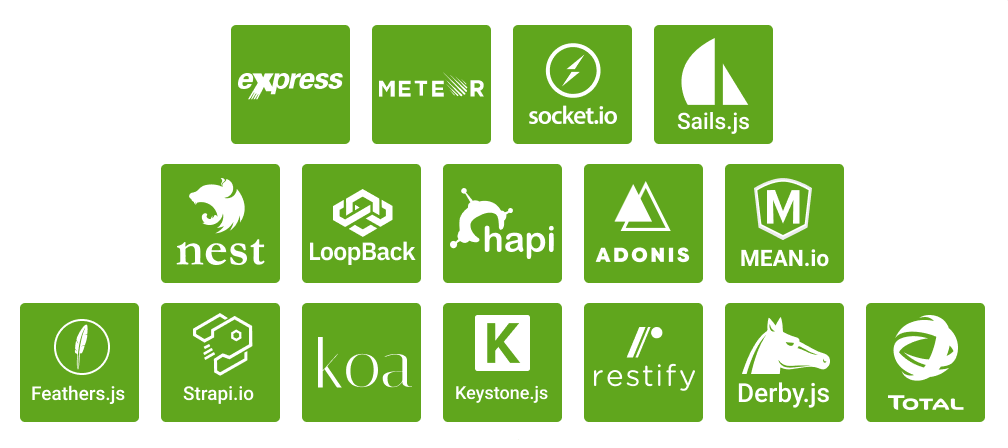
What is Node.JS: Node.js is an open-source and free environment for cross-platform app development. Developers can write command-line tools and server-side scripts even on server.
What is a Real-Time Application: Real-Time application monitors the static/dynamic behaviour of a system by the time (at that moment). Process control applications, traffic management systems are some examples.
JavaScript was perceived to be used only at the client-side and the developers had to use any of the traditional technologies (Java, PHP, .Net) to run JavaScript on both clients as well as the server-side. Node.JS eventually emerged with the concept to run on the client-side as well as the server-sides. It is based on an event-driven and non-blocking I/O model. It is a front-end programming language like JavaScript and makes use of a single thread to process tasks quickly. If we make use of Node.js as a server, we will eventually be making use of JavaScript. We can create an entire application using JavaScript from the client-side database.
Quick Tip: We can use Node.JS to create simple web servers with few lines of code.
JavaScript was originally developed to run only on the browser (client-side). It manipulates the DOM and simultaneously adds a bit of interactivity to the website. The V8 JavaScript Engine provided by Chrome compiles the JavaScript code into machine code and makes a computer work more efficiently.
Node.js gained popularity as users were able to write server-side code with JavaScript. The creators of Node.js took the V8 code base and added multiple features to it which made it possible for Node.js users to build servers with JavaScript. It is now easy to build a server that connects to the database to fetch and store data, authenticate users, validate input and handle business logic.
Node.js can also be used for writing utility scripts or for building tools. Node.JS is prevalent for web development and to create server-side code. It can access a file system so that it can read, write, and manipulate files; it therefore can handle many utility tasks on the computer without exposing files to the public.
Node.js makes use of an event-driven code for executing the program logic which makes the JavaScript thread always free to handle new events and new incoming requests.
Node.js can register callbacks and events to be executed in asynchronous code instead of direct execution of code. This enables Node.js to execute in a non-blocking state and simultaneously makes the apps highly performant.
Quick Note: We’ll skip the complex code in this excerpt.
Interested already? Let’s get started!
JavaScript is quick, occupies less space, and is lightweight which makes it suitable to write quick scripts for client browsers and servers. It becomes easy to implement JavaScript with Node.js as its use across the stack unifies the JSON data format which allows optimal utilization of programming resources. Both client and server sides can interact in real-time which is known as a state-full request-response request with free data exchange in Node.js.
Based on Google’s V8 JavaScript Engine, Node.js is an open-source, cross-platform runtime environment for server-side apps. Such apps use JS and can run within the Node.js runtime. Suitable environments for developing Node.js apps include – OS X, Microsoft Windows, Linux, Non-Stop, FreeBSD, Mac OS X, UNIX and IBM. All the JavaScript that we write is compiled on Google’s V8 Engine.
Node.js is an environment or a server engine (it’s not a library/script file) upon which we have to build a program. Writing everything from scratch becomes complex and therefore we can make use of the framework to ease off this process. While creating an application from scratch we need to make use of the core Node module, HTTP, and other stuff. As we install Node.JS we simultaneously get NPM as well. We can install all other global and local components from NPM.
Node.JS was created to build websites with real-time push capability. This feature was first implemented by Google in its Gmail mail-server application. This was based on an event-driven paradigm (which is the basis of Node.JS).
Many more applications like Netflix, Uber, eBay, LinkedIn, PayPal, Walmart, Medium, Twitter, Trello, PayPal, Medium, Groupon, Yahoo, Mozilla, Airbnb, and GoDaddy etc., followed this and were created in Node.JS later.

Basic rules with Node.JS are similar to other environments and programming languages including initializing variables, declaring functions and event loops.
There can be multiple combinations, but these are those that require and reproduce solutions in real-time:
Let’s consider an example of creating a simple server in Node.js (in real-time):
Prerequisite Download
Step 1: Creating a directory for the server application by typing “mkdir [directory name]” in your terminal Step 2: Open this directory into your text editor
Step 3: Create server.js and routes.js files with this directory (Note: We will create a server.js file to import all necessary components to set up a server. This will help us to listen to all client requests; we will create a routes.js file to handle client requests and send a reciprocal response to the browser.)
Step 4: Import HTTP module in server.js using require () keyword, create an HTTP constant and require HTTP
Step 5: Import routes into server.js and create a server by createServer() method that has two parameters: HTTP request(req) and response(res). Routes can be passed by defining requestListener in routes.js.
Step 6: Create a server by declaring the server as a constant and set it equal to createServer method and pass routes as its argument. (Note: To pass routes as an argument, import routes.js into server.js. Declare routes as a constant and provide the file path)
Step 7: The server needs to listen to the incoming request from the browser. This can be accomplished by using the listen() method to create a listener on a specified port. Pass a value as an argument in the server.listen() method.
This configures our server.js to create a server. Now let’s focus on routes.js.
Step 8: To accomplish this, we need to create a requestListener function that takes in the client request and server response as arguments. As we build routes to handle various client requests and send an appropriate response to the browser, we need to create a requestListener in routes.js and export routes, createServer() method in server.js accepts a requestListener function. However, we passed routes as an argument instead as we are defining requestListener in routes.js. For this, we need to export the routes file so that routes could be imported into server.js. This can be accomplished by using the ‘module.exports’ keyword. The requestListener is a function that is executed whenever the server receives an incoming request. This function takes in two arguments: request: incoming, response: serverResponse.
Step 9: Type in localhost: 3000 in the URL bar (Note: 3000 is an example; it should be any value that we passed in the above steps); nothing comes up on the page; go-to text editor, the request object will include some information as key-value pairs. (Note: We need to manually start our server every time we wish to see the results after we make any changes to the code. However, we can use tools to accomplish this.)
Step 10: Refresh the browser and go back to the text editor. You will find the Url in the request object highlighted with a red box.
Step 11: Configure a “/” route to display a message and an interactive form (Note: The browser/localhost sends a GET request to the server but the browser does not display anything yet as the server does not send back a response. We can write frontend code or HTML code to get displayed on the server by replacing the code in routes.js. The requested URL will determine the response to be sent to the client. In case we are writing HTML code, determine the H1 tag, P tag, form tag, input tag.
Step 12: Close it off with res.end()
Step 13: Restart the server by exiting out with server (control+C) and server(node server.js)
Step 14: Check the client browser, you’ll find the response displayed there (Get request will get the status code 200 which implies that the request succeeded at getting appropriate data from the server (green box). Response headers (orange box) and response tab (red box) will show the content of your response on the server.
Step 15: By this, we have been able to create a route for the get request and send the response to the browser. The next step is to save the user’s input in a separate file.
Step 16: Node.js reads some part of the code bit by bit, processes the content and keeps it in memory. These bits are regrouped later into buffers to become recognizable by code and start working with the data. This increases the memory and time efficiency of the application.
The factors that should be considered while selecting the Node.js framework must be verified by:
Here is a list of some node.js frameworks supported by Node.js. Most of these are based on MVC web application architecture.

Node.js frameworks are configuration-centric, have a connect style middleware, and offer features like input validation, authentication, caching and are flexible and creating dynamic end-to-end REST APIs.
Full-stack developers got to shuffle multiple programming paradigms, have to shift environments, follow multiple rules, and make use of multiple programming languages to create the frontend and backend of the applications. Developers often mix and match the syntax of JavaScript and Ruby as they switch back and forth between the frontend and backend. We have tried illustrating real-time app development in Node.js here, hope it was helpful. Need more information or simply wish to know our expertise on node.js application development, reach out to us!



Vipin Jain is the Co-Founder and CEO at Konstant Infosolutions and is in charge of marketing, project management, administration and R&D at the company. With his marketing background, Vipin Jain has developed and honed the company’s vision, corporate structure & initiatives and its goals, and brought the company into the current era of success.
Or send us an email at: [email protected]